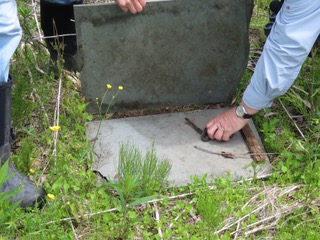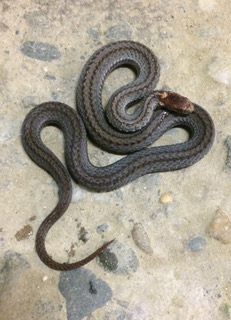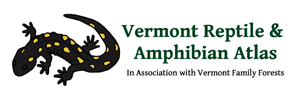
Herp Update: Current Herp Activity – August 2, 2023
Current Herp Activity
Snakes
We monitor the populations of snakes at a site in Lincoln that is part of the Colby Hill Ecological Project. At this site we have put out a series of 45 slate sandwiches with wooden spacers (see photo). The slate absorbs the heat from the sun during the day and holds it into the night. The covers provide both protection and heat for the snakes. At this time of year we do our annual maintenance along the cover transects. This involves replacing covers that have been moved by the local bears (checking for ants and bees), renumbering the slates if needed, and clearing away grasses, shrubs, and overhanging branches that shade the covers. While doing the maintenance, we check to see what snakes are using the covers, we check them for signs of disease, measure them, check to see if they are gravid (pregnant) and if so, how many young they are going to have, or how many eggs they are going to lay.
We have four species of snake that use our snake covers at the Lincoln site: Red-bellied Snakes, Common Gartersnakes, Eastern Milksnakes, and DeKay’s Brownsnakes. Although we have been monitoring snakes along this transect since 2001, the DeKay’s Brownsnake did not show up until 2020, and we have found them annually since. We are not sure why they showed up only recently. It could be the result of climate warming (DeKay’s Brownsnakes are usually found at lower elevations), or perhaps changes in the way the field is being managed (it is no longer being hayed, but only cut once a year).
Most of the snakes that we find during our summer maintenance are gravid females. By gently pressing our fingers against the underside of the snake, we can feel the embryos inside the mothers and we can count them. During our recent maintenance we found many gravid Red-bellied Snakes. The number of embryos inside these female Red-bellied Snakes ranged from eight to fourteen. Red-bellied Snakes give live birth. The only egg-laying snake at this site is the Eastern Milksnake. Most of the snakes will have given birth (or laid their eggs) by the end of August. We have only found two snakes that were still carrying their embryos into early September.
Red-bellied Snakes are unique among our Lincoln snakes in that they appear in a variety of color morphs. Most have medium brown backs, but some are light tan, dark brown, light gray, dark gray, and even black (see photos). However, all color morphs we have seen had their characteristic red bellies.
Frogs
We have had reports of some species of frogs having transformed from tadpoles and left the water. Many of the Northern Leopard Frogs, Wood Frogs, Spring Peepers, and American Toads that were laid as eggs earlier this year have now metamorphosed and moved onto land. Young Green Frogs have also started transforming, but they were laid as eggs either last year or the year before. They spend one or two winters under the ice as tadpoles.






